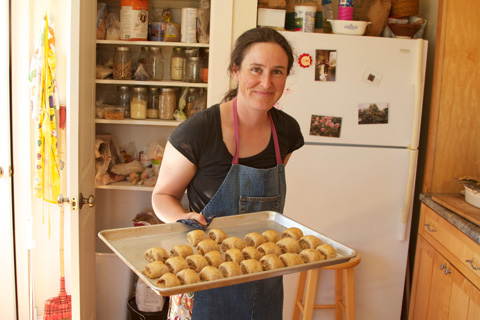
PERFECTLY CONTAINED Briana Robillard shows off a tray of sausage rolls. |
Upon learning that I write this Immigrant Kitchens column, my new neighbor, Ursula, said, "You've got to call my friend from New Zealand. She brings these sausage roll things to every party, and they're delicious."
What about sausage could not be delicious? I wondered. It was the wrong question. I tried to take it back, but it was out there, twisting in the wind, the answer flying to it like bugs into bug tape. The "sausage casing," which — let's face it — is pig intestine, which is practically the bowel, is something about sausage that is not delicious. It's gross! Great. Now I'm going to be blamed for ending the long and prosperous sausage-eating careers of Portland Phoenix readers everywhere. But lo! There on the horizon is a farm on a hill. There, New Zealander Briana Robillard is going to show us all how to fix this, and we'll all be eating sausage with glee again in no time.
New Zealand sausage rolls, a food traditionally served to sheep shearers after a hard day's work, are basically seasoned loose sausage wrapped inside pie dough into neat little bites and baked. No intestine, folks. Americans have their own version of sausage rolls — pigs in a blanket — but these seem to be missing the point entirely. The ground meat is doubly contained — first in Vienna sausage casing, then in dough. Who needs extraneous intestine in their diet? It's not like we eat the intestine for the flavor. All we want is containment capability! And pie dough has it.
As ubiquitous as sausage rolls are in New Zealand, Robillard had never actually made them herself before coming to the US. "I didn't ever cook sausage rolls there because I never needed to. They're everywhere. It's like French fries are here." It wasn't until she was actually shearing alpaca at a farm in Freeport that she realized that there likely would be no sausage rolls available. She thought, "You have to feed sausage rolls to shearers!" And made a mad dash for the Internet and then a grocery store.
She put ground pork in a mixing bowl with egg, breadcrumbs, milk, scallion, sage, basil, and salt. Then in a separate bowl she mixed flour, salt, butter, and water into dough with her hands. Though she wasn't a highly trained baker, she rolled that dough out with complete confidence. She was the type of person who buys her flour in 30-pound sacks. She got some of her confidence from 30 years of farming and home cooking experience, and some from this cooking motto: "If you feed it to hungry people, it'll be fine." She cut the dough into a large rectangle and put the meat filling in a line down the long middle. Then she folded the dough over the meat like a business letter. Slicing across the result turned the roll into a whole bunch of bite-sized pieces, which she placed on a greased sheet pan and baked in the oven.
Though my daughters and I sheared no sheep, Briana offered us as many of these golden little meat nuggets as we liked, right off the cooling rack. "Mm! Tastes like pot-pie!" My seven-year-old said. Nothin' like meat in pie crust.
Then Briana proceeded to make a dessert called strawberry pavlova, which is basically a meringue raft slathered with two inches of whipped cream and topped with a mountain of sliced fresh strawberries. We've been saved. ^
For the recipes and cooking class info, visit ImmigrantKitchens.com.